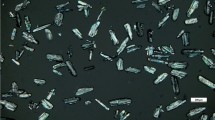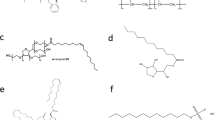Abstract
Purpose
To develop an in silico model that provides an accurate prediction of the relative solubility of the lipophilic anticancer agent docetaxel in various excipients.
Materials and Methods
The in silico solubility of docetaxel in the excipients was estimated by means of the solubility (δ) and Flory-Huggins interaction (χ FH) parameters. The δ values of docetaxel and excipients were calculated using semi-empirical methods and molecular dynamics (MD) simulations. Cerius2 software and COMPASS force-field were employed for the MD simulations. The χ FH values for the binary mixtures of docetaxel and excipient were also estimated by MD simulations.
Results
The values obtained from the MD simulations for the solubility of docetaxel in the various excipients were in good agreement with the experimentally determined values. The simulated values for solubility of docetaxel in tributyrin, tricaproin and vitamin E were within 2 to 6% of the experimental values. MD simulations predicted docetaxel to be insoluble in β-caryophyllene and this result correlated well with experimental studies.
Conclusions
The MD model proved to be a reliable tool for selecting suitable excipients for the solubilization of docetaxel.




Similar content being viewed by others
References
S. W. Yi, Y.-H. Kim, I. C. Kwon, J. W. Chung, J. H. Park, Y. W. Choi, and S. Y. Jeong. Stable Lipiodolized emulsions for hepatoma targeting and treatment by transarterial chemoembolization. J. Control. Release 50:135–143 (1998).
I.-H. Lee, Y. T. Park, K. Roh, H. Chung, I. C. Kwon, and S. Y. Jeong. Stable paclitaxel formulations in oily contrast medium. J. Control. Release 102:415–425 (2005).
R. G. Strickley. Solubilizing Excipients in Oral and Injectable Formulations. Pharm. Res. 21:201–230 (2004).
M. N. Khalid, P. Simard, D. Hoarau, A. Dragomir, and J.-C. Leroux. Long circulating poly(ethylene glycol)-decorated lipid nanocapsules deliver docetaxel to solid tumors. Pharm. Res. 23:752–758 (2006).
P. Kan, Z.-B. Chen, C.-J. Lee, and I.-M. Chu. Development of nonionic surfactant/phospholipid o/w emulsion as a paclitaxel delivery system. J. Control. Release 58:271–278 (1999).
J. G. Wenzel, K. S. Balaji, K. Koushik, C. Navarre, S. H. Duran, C. H. Rahe, and U. B. Kompella. Pluronic F127 gel formulations of deslorelin and GnRH reduce drug degradation and sustain drug release and effect in cattle. J. Control. Release 85:51–59 (2002).
C. A. Lipinski, F. Lombardo, B. W. Dominy, and P. J. Feeney. Experimental and computational approaches to estimate solubility and permeability in drug discovery and development settings. Adv. Drug Deliv. Rev. 23:3–25 (1997).
M. E. Aulton. Pharmaceutics: The Science of Dosage Form Design 2nd ed.; Elsevier Science Limited: Churchill Livingstone, 2002.
M. Kreilgaard. Influence of microemulsions on cutaneous drug delivery. Adv. Drug Deliv. Rev. 54:S77–S98 (2002).
N. S. Bhattachar, L. A. Deschenes, and J. A. Wesley. Solubility: it's not just for physical chemists. Drug Discov. Today 11:1012–1018 (2006).
B. E. Eichinger, D. Rigby, and J. Stein. Cohesive properties of Ultem and related molecules from simulations. Polymer 43:599–607 (2002).
S. S. Patnaik, and R. Pachter. A molecular simulations study of the miscibility in binary mixtures of polymers and low molecular weight molecules. Polymer 43:415–424 (2002).
J. Ennari, L.-O. Pietilä, V. Virkkunen, and F. Sundholm. Molecular dynamics simulation of the structure of an ion-conducting PEO-based solid polymer electrolyte. Polymer 43:5427–5438 (2002).
T. Li, D. O. Kildsig, and K. Park. Computer simulation of molecular diffusion in amorphous polymers. J. Control. Release 48:57–66 (1997).
J. H. Poupaert, and P. Couvreur. A computationally derived structural model of doxorubicin interacting with oligomeric polyalkylcyanoacrylate in nanoparticles. J. Control. Release 92:19–26 (2003).
T. Spyriouni, and C. Vergelati. A molecular modeling study of binary blend compatibility of polyamide 6 and poly(vinyl acetate) with different degrees of hydrolysis: an atomistic and mesoscopic approach. Macromolecules 34:5306–5316 (2001).
M. Zhang, P. Choi, and U. Sundararaj. Molecular dynamics and thermal analysis study of anomalous thermodynamic behavior of poly (etherimide)/polycarbonate blends. Polymer 44:1979–1986 (2003).
S. H. Jacobson. Molecular modeling studies of polymeric transdermal adhesives: structure and transport mechanisms. Pharmaceutical Technology 23:122–130 (1999).
Y.-M. Lam, G. Goldbeck-Wood, and C. Boothroyd. Mesoscale Simulation and cryo-TEM of Nanoscale Drug Delivery Systems. Molecular Simulation 30:239–247 (2004).
G. Srinivas, D. E. Discher, and M. L. Klein. Self-assembly and properties of diblock copolymers by coarse grain molecular dynamics. Nature Materials 3:638–644 (2004).
G. Srinivas, and M. L. Klein. Coarse-grain molecular dynamics simulations of diblock copolymer surfactants interacting with a lipid bilayer. Molec. Phys. 102:883–889 (2004).
D. Pavel, and J. Lagowski. Computationally designed monomers and polymers for molecular imprinting of theophylline and its derivatives. Polymer 46:7528–7542 (2005).
O. Pradier, M. Rave-Fränk, J. Lehmann, E. Lücke, O. Boghun, C.-F. Hess, and H. Schmidberger. Effects of docetaxel in combination with radiation on human head and neck cancer cells (ZMK-1) and cervical squamous cell carcinoma cells (CASKI). Int. J. Cancer 91:840–845 (2001).
J. E. Cortes, and R. Pazdur. Docetaxel. J. Clin. Oncol. 13:2643–2655 (1995).
E. K. Rowinsky, and R. C. Donehower. Drug therapy: paclitaxel (Taxol). N. Engl. J. Med. 332:1004–1014 (1995).
U.S. Food and Drug Administration, date of access: May 2007, http://www.fda.gov/bbs/topics/news/2004/NEW01068.html.
U.S. Food and Drug Administration, date of access: May 2007, http://www.fda.gov/bbs/topics/NEWS/2006/NEW01493.html.
U.S. Food and Drug Administration, date of access: May 2007, http://www.fda.gov/bbs/topics/ANSWERS/2001/ANS01101.html.
U.S. Food and Drug Administration, date of access: May 2007, http://www.fda.gov/cder/rdmt/internetftap.htm.
U.S. Food and Drug Administration, date of access: May 2007, http://www.cancer.gov/cancertopics/druginfo/fda-docetaxel.
J. H. Hildebrand, and R. L. Scott. The Solubility of Nonelectrolytes, 3rd ed., Reinhold Publishing Corporation, New York, 1950.
W. Blokzij, and J. B. F. N. Engberts. Hydrophobic effects. Opinions and facts. Angew. Chem. Int. Ed. Engl. 32:1545–1579 (1993).
M. H. Abraham. Scales of solute hydrogen-bonding: their construction and application to physicochemical and biochemical processes. Chem. Soc. Rev. 22:73–83 (1993).
R. F. Fedors. A method for estimating both the solubility parameters and molar volumes of liquids. Polym. Eng. Sci. 14:147–154 (1974).
E. Ruckenstein, and I. Shulgin. Solubility of drugs in aqueous solutions. Part 1. Ideal mixed solvent approximation. Int. J. Pharm. 258:193–201 (2003).
Accelrys Software Inc., Cerius2 Simulation & Prediction, Release 4.6, San Diego: Accelrys Software Inc., 2001.
T. Higuchi, and K. A. Connors. Phase-solubility techniques. Advan. Anal. Chem. Instr. 4:117–212 (1965).
H. van der Waterbeemd, H. Lennernäs, P. Artursson. Drug Bioavailability: Estimation of Solubility, Permeability, Absorption and Bioavailability. Wiley VCH Verlag GmbH & Co. KGaA, Weinheim, 2003, Chapters 1 and 6.
M. M. A. Omari, M. B. Zughul, J. E. D. Davies, and A. A. Badwan. Thermodynamic enthalpy–entropy compensation effects observed in the complexation of basic drug substrates with β-cyclodextrin. J. Incl. Phenom. Macrocycl. Chem. 57:379–384 (2007).
K. G. H. Desain, and H. J. Park. Solubility studies on valdecoxib in the presence of carriers, cosolvents, and surfactants. Drug Dev. Res. 62:41–48 (2004).
R. Singh, M. Ajagbe, S. Bhamidipati, Z. Ahmad, and I. Ahmad. A rapid isocratic high-performance liquid chromatography method for determination of cholesterol and 1,2-dioleoyl-sn-glycero-3-phosphocholine in liposome-based drug formulations. J. Chromatogr. A 1073:347–353 (2005).
B. Vaisman, A. Shikanov, A. J. Domb. Normal phase high performance liquid chromatography for determination of paclitaxel incorporated in a lipophilic polymer matrix. J. Chromatogr. A 1064:85–95 (2005).
S. K. Tahir, M. A. Nukkala, N. A. Z. Mozny, R. B. Credo, R. B. Warner, Q. Li, K. W. Woods, A. Claiborne, S. L. Gwaltney, D. J. Frost, H. L. Sham, S. H. Rosenberg, and S.-C. Ng. Biological activity of A-289099: an orally active tubulin-binding indolyloxazoline derivative. Mol. Cancer Ther. 2:227–233 (2003).
D. W. van Krevelen. Properties of Polymers. 3rd ed.; Elsevier Scientific Pub. Co.: New York, 1990.
M. Waldman, and A. T. Hagler. New combining rules for rare gas van der waals parameters. J. Comput. Chem. 14:1077–1084 (1993).
P. Gestoso, and J. Brisson. Towards the simulation of poly(vinyl phenol)/poly(vinyl methyl ether) blends by atomistic molecular modelling. Polymer 44:2321–2329 (2003).
J. A. Mason, and L. H. Sperling. Polymer Blends and Composites; Plenum Press: New York, 1976.
J. A. McCammon. Dynamics of Proteins and Nucleic Acids; Press Syndicated of the University of Cambridge: New York, 1989; pp. 60–65.
M. P. Allen, and D. J. Tildesley. Computer Simulation of Liquids; Claredon Press Oxford, 1987.
H. Sun. COMPASS: An ab Initio Force Field optimized for condensed-phase applications-overview with details on alkane and benzene compounds. J. Phys. Chem. B 102:7338–7364 (1998).
D. Rigby, H. Sun, and B. E. Eichinger. Computer simulations of poly(ethylene oxide): force field, PVT diagram and cyclization behavior. Polym. Inter. 44:311–330 (1997).
M. J. Hwang, T. P. Stockfisch, and A. T. Hagler. Derivation of class II force fields. 2. Derivation and characterization of a class II force field, CFF93, for the alkyl functional group and alkane molecules. J. Am. Chem. Soc. 116:2515–2525 (1994).
J. M. G. Cowie. Polymers: Chemistry and Physics of Modern Materials, 2nd ed.; Nelson Thornes Ltd.: Cheltenham, 1991, Chapter 8.
C. F. Fan, B. D. Olafson, and M. Blanco. Application of molecular simulation to derive phase diagrams of binary mixtures. Macromolecules 25:3667–3676 (1992).
F. H. Case, and J. D. Honeycutt. Will my polymers mix? - Applications for modeling to study miscibility, compatibility and formulation. TRIP 2:256 (1994).
P. J. Flory. Principles of Polymer Chemistry; Cornell University Press: Ithaca, New York, 1953.
D. Merino-Garcia, and S. Correra. A shortcut application of a Flory-like model to asphaltene precipitation. J. Dispersion Sci. Technol. 28:339–347 (2007).
P. Bahadur, and N. V. Sastry. Principles of Polymer Science, 2nd ed.; Alpha Science International Ltd.: Oxford, UK, 2005, Chapter 8.
H. Elbs, and G. Krausch. Ellipsometric determination of Flory-Huggins interaction parameters in solution. Polymer 45:7935–7942 (2004).
Polymer Data Handbook, Oxford University Press, Inc., 1999.
M. R. Paillasse, C. Deraeve, P. de Medina, L. Mhamdi, G. Favre, M. Poirot, S. Silvente-Poirot. Insights into the cholecystokinin 2 receptor binding site and processes of activation. Mol. Pharmacol. 70:1935–1945 (2006).
S. Nosé. Constant temperature molecular dynamics methods. Prog. Theoret. Phys. Supplement 103:1–46 (1991).
S. Nosé. A molecular dynamics method for simulations in the canonical ensemble. Molec. Phys. 52:255–268 (1984).
D. Orloff, date of access: May 2007, http://www.fda.gov/cder/foi/label/2002/18920s024lbl.pdf.
U.S. Food and Drug Administration, date of access: May 2007, http://www.fda.gov/cder/foi/label/2004/21671_depoDur_lbl.pdf.
U.S. Food and Drug Administration, date of access: May 2007, http://www.fda.gov/cder/da/da0900.htm.
U.S. Food and Drug Administration, date of access: May 2007, http://www.accessdata.fda.gov/scripts/cdrh/cfdocs/cfcfr/CFRSearch.cfm?fr=172.515.
U.S. Food and Drug Administration, date of access: May 2007, http://www.accessdata.fda.gov/scripts/cdrh/cfdocs/cfcfr/CFRSearch.cfm?fr=184.1903.
U.S. Food and Drug Administration, date of access: May 2007, http://www.fda.gov/cder/da/ddpa296.htm.
D. Mastropaolo, A. Camerman, Y. Lou, G. D. Brayer, and N. Camerman. Crystal and molecular structure of paclitaxel (Taxol). Proc. Natl. Acad. Sci. 92:6920–6924 (1995).
R. T. Liggins, W. L. Hunter, and H. M. Burt. Solid-state characterization of paclitaxel. J. Pharm. Sci. 86:1458–1463 (1997).
L. Zhao, and S.-S. Feng. Effects of lipid chain length on molecular interactions between paclitaxel and phospholipid within model biomembranes. J. Colloid Interface Sci. 274:55–68 (2004).
J. H. Yin, Y. Noda, N. Hazemoto, and T. Yotsuyanagi. Distribution of protease inhibitors in lipid emulsions: gabexate mesilate and camostat mesilate. Chem. Pharm. Bull. 53:893–898 (2005).
D. J. Greenhalgh, A. C. Williams, P. Timmins, and P. York. Solubility parameters as predictor of miscibility in solid dispersions. J. Pharm. Sci. 88:1182–1190 (1999).
T. V. M. Sreekanth, and K. S. Reddy. Analysis of solvent-solvent interactions in mixed isosteric solvents by inverse gas chromatography. Chromatographia 65:325–330 (2007).
J. de Wit, G. A. van Ekenstein, and G. ten Brinke. Interaction between poly(vinyl pyridine) and poly(2,6-dimethyl-1,4-phenylene oxide): A copolymer blend miscibility study. Polymer 48:1606–1611 (2007).
G. O. R. A. van Ekenstein, R. Meyboom, and G. ten Brinke. Determination of the Flory-Huggins interaction parameter of styrene and 4-vinylpyridine using copolymer blends of poly(styrene-co-4-vinylpyridine) and polystyrene. Macromolecules 33:3752–3756 (2000).
S. M. Ali, M. Z. Hoemann, J. Aubé, L. A. Mitscher, G. I. Georg, R. McCall, and L. R. Jayasinghe. Novel cytotoxic 3'-(tert-butyl) 3'-dephenyl analogs of paclitaxel and docetaxel. J. Med. Chem. 38:3821–3828 (1995).
Acknowledgments
The authors are grateful to Natural Sciences and Engineering Research Council (NSERC) for funding this research.
Author information
Authors and Affiliations
Corresponding author
Electronic supplementary material
Below is the linked to the electronic supplementary material
ESM 1
(DOC 78.0 KB)
Rights and permissions
About this article
Cite this article
Huynh, L., Grant, J., Leroux, JC. et al. Predicting the Solubility of the Anti-Cancer Agent Docetaxel in Small Molecule Excipients using Computational Methods. Pharm Res 25, 147–157 (2008). https://doi.org/10.1007/s11095-007-9412-3
Received:
Accepted:
Published:
Issue Date:
DOI: https://doi.org/10.1007/s11095-007-9412-3




